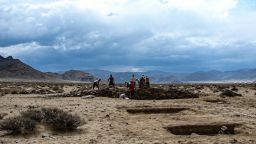Rising sea levels may have forced the Vikings out of a successful settlement

Sign up for CNN’s Wonder Theory science newsletter. Explore the universe with news on fascinating discoveries, scientific advancements and more.
The Vikings disappeared abruptly from Greenland in the mid-15th century, some 400 years after arriving there. Why they abandoned a successful settlement is a mystery that historians never have been able to fully explain.
Theories include drought, changing temperatures, social unrest, and the overhunting of walrus tusks (a cherished luxury good in medieval Europe) — conditions that would have made Norse colonies in Greenland economically nonviable.
Now, a team of researchers from Harvard University and Pennsylvania State University say they have uncovered another key factor that could explain why the Vikings fled: a rise in sea levels.
Using a computer model based on geological and climate records, the team found that sea levels would have risen by up to 3 meters (9.8 feet) during the the four centuries of Norse occupation of the eastern settlement Vikings established in Greenland in 985 AD.
The researchers calculated that 204 square kilometers (79 square miles) of land would have been been flooded during the period the settlement was occupied, making Norse communities more vulnerable to storms and coastal erosion as they also lost fertile lowland.
The loss of habitable land would have been compounded by a trend from warmer temperatures toward cooler, drier temperatures in Europe that ultimately led to what is known as the Little Ice Age, which began around 1250 AD. A study detailing the findings published Monday in the scientific journal PNAS.
“Sea-level change is an integral, missing element of the Viking story,” said study coauthor Richard Alley, Evan Pugh University Professor of Geosciences at Penn State.
Analyses of human remains from church yards and animal remains from trash piles also showed that, over the time period, the diet of Viking settlers switched from land-based foods such as livestock to marine resources like fish and seals, the researchers noted. This change might have been due to the loss of land that was suitable for growing crops.
The idea that sea levels would have been rising as temperatures fell is a little counterintuitive, according to the researchers. Cooler global temperatures are usually associated with falling sea levels.
However, Earth’s oceans aren’t like a bathtub, and the study noted that changes in sea level don’t affect all areas equally.
The Norse settlement would have been subject to two components of sea level change, because it was located on the periphery of the Laurentide Ice Sheet — which covers Canada, the northeastern United States, and the Arctic — and the Greenland Ice Sheet.
The Greenland Ice Sheet readvanced during Viking occupation of the eastern settlement and peaked in the Little Ice Age. That advance caused sea level rise near the ice margins because of the sinking of Earth’s crust, according to the study.
“The readvance pushed down the land around it, something like the dent that forms around you if you sit on a waterbed; less intuitively, the mass of ice is so large that it significantly attracts the ocean to it,”, Alley explained in a news release.
“The greater ice mass close to the shore raised the ocean,” he added.
In a separate study also published Monday, researchers found that Viking voyagers shipped timber across huge distances from North America and northern Europe because native trees in Greenland were unsuitable for shipbuilding and constructing large land-based projects.
Microscopic analysis of timber remains, published in the journal Antiquity, showed that Norse Greenlanders had the means, knowledge and appropriate vessels to cross the North Atlantic to the east coast of North America, at least up until the 14th century.




No comments:
Post a Comment